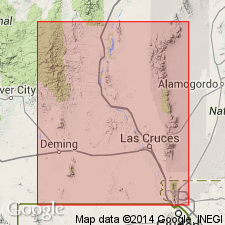
- Usage in publication:
-
- Palm Park formation
- Modifications:
-
- Named
- Dominant lithology:
-
- Tuff
- Breccia
- Conglomerate
- Clay
- Silt
- AAPG geologic province:
-
- Orogrande basin
Summary:
Named from a valley known as Palm Park, located along southeastern edge of Caballo area, Sierra Co, NM, in Orogrande basin, designated the type locality. Nowhere is there a complete section; lower part of formation dropped below surface along Palm fault. Elsewhere, lower or upper boundaries may be covered by younger pediment-capping sediments. Base is exposed along Apache Canyon, where stands steeply but in near conformity with underlying Magdalena beds. Locally exposed in Ts16 and 17S, Rs3 and 4W. Generally reddish in outcrop. Consists in some places of very coarse, bouldery conglomerate. In Apache Canyon, contains blocks as much as 12 ft in diameter. Red color apparently due to debris derived from Abo formation; here, also, fragments of Precambrian and nearly all Paleozoic formations are present. At Palm Park, where upper part is exposed, contains much reddish, grayish, and purplish-brown latitic to andesitic breccia and tuff. Reddish-brown tuffaceous clay and silt commonly intercalated with the tuff and breccia. Thickness undetermined--probably at least 1,000 ft in southern end of Caballo Mountains. Palm Park lithologically similar to part of Datil formation. Younger than Cretaceous-Tertiary McRae formation (new)--no direct relationship between them determined. Underlies Thurman formation (new), which is below Miocene-Pliocene Santa Fe beds. Age is Tertiary.
Source: GNU records (USGS DDS-6; Denver GNULEX).
For more information, please contact Nancy Stamm, Geologic Names Committee Secretary.
Asterisk (*) indicates published by U.S. Geological Survey authors.
"No current usage" (†) implies that a name has been abandoned or has fallen into disuse. Former usage and, if known, replacement name given in parentheses ( ).
Slash (/) indicates name conflicts with nomenclatural guidelines (CSN, 1933; ACSN, 1961, 1970; NACSN, 1983, 2005, 2021). May be explained within brackets ([ ]).

